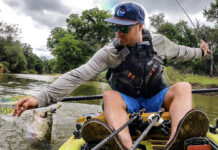Catching a conger eel large enough to qualify for membership in the British Conger Club (BCC) is a challenge, and Mike Burnett, Greg Bowes and Mark Kemble were determined to accomplish the goal from their kayaks.
To qualify for the BCC, it is necessary to catch a conger eel over 30 pounds from open ground or 40 pounds from a wreck. The average size of a conger is between 10 and 40 pounds, but the current IGFA All-Tackle record is 133 pounds, four ounces with the largest conger ever recorded a 350-pound monster.
How to Catch Conger Eels and Live to Tell About It

Bristol Channel off the coast of South Wales has a healthy population of sizeable eels; however, most of the largest eels are too far offshore for even the most experienced kayak anglers.
So, Burnett, Bowes and Kemble chartered Captain Rob Rennie on the Lady Jue for a ride to the fishing grounds.
The Bristol Channel seabed between the Welsh coast and Exmore consists of mud, sand and gravel, punctuated by larger sand banks and shallow, rocky reefs. The rusting hulk of the wreck is perfect habitat for the plethora of small fish, crustaceans and other food for foraging eels.
The first challenge was anchoring in 100 feet of water, especially since the Bristol Channel experiences the second-highest tidal range anywhere in the world. Anchoring requires almost 300 feet of line and 10 feet of chain connected to a Bruce or plow anchor.
Conger eel catching techniques
Fishing for conger involves presenting a stationary bait hard on the seabed. A simple running lead rig with a barbless 10/0 to 12/0 bronze hook is easy to remove and will corrode if left in the fish. For bait, a chunk of cut mackerel, cuttlefish or squid will entice a conger to bite.
The optimal time to catch conger is during the slack water period until the next tide starts. Not long after the anglers set up, the first bites came from lesser spotted dogfish. Then Mark Kemble hooked a fish that was not another dogfish.
With his rod bent almost double, feet dangling over the side of his kayak into the murky channel water, he steadily pumped the fish toward the kayak. When the fish’s head and thrashing tail broke the surface, the kayakers could see a decent conger eel. Mark quickly released the 20-pounder, re-baited, dropped back down and almost immediately hooked up with another lively eel.
As the tide started to ease, all three kayakers were catching a near-constant succession of eels. Although they didn’t break the 40-pound mark for entry into the BCC, the steady action on fish up to 30 pounds left the anglers more than satisfied with their incredible success.
After hours of action, the bite shut down at the same time the powerful force of flowing water started to exert excessive pressure on the kayaks. It was clear the trip had come to an end. In short order, the anglers stowed the kayaks aboard Lady Jue and headed back to port to mull over the day’s adventure and plan the next kayak challenge the lads would attempt.
A trophy only a mother could love. | Feature photo: David Lewis









